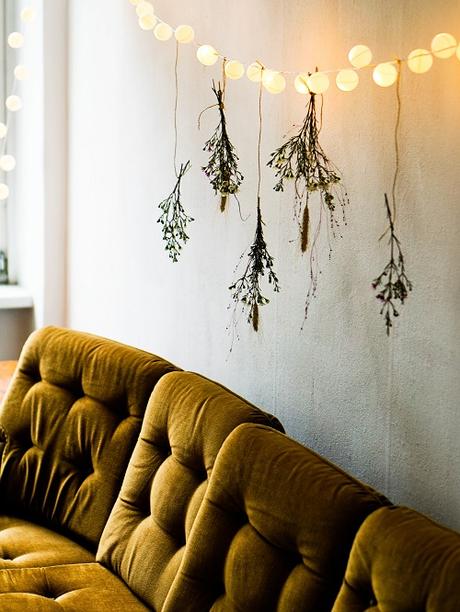This DIY lighting project is quick, easy and economical, and a great way to get those creative (and frugal) juices flowing. My daughter and I worked on this project together, and we both agreed it gave a warm glow to the room and instantly transformed the ambience.
You can also personalise your lights in many ways, such as decorating the ping pong balls beforehand, or hanging dry flowers from them like we did.
What lights should I use?
If you’re wondering whether you can finally put those extra Christmas lights to good use, the answer is yes, as long as the bulbs don’t get hot. You need to use LED bulbs which stay cool to the touch, so always check this first.
Whether you use white or coloured lights is up to you. As ping pong balls are translucent, the color of the lights will shine through and create a warm, decorative effect (but they’ll both look the same during the day).

Brighten up your patio
As well as looking great hanging along an inside wall, you can also use them to illuminate a gazebo, pergola, patio, or just about any outside area. Just make sure your lights are rated for outdoor use.
To protect your lights from the rain, you can use a waterproof silicone sealer. Just cover each bulb socket with a small amount of silicone and spread it around the X you’ve made with a precision knife (see Step 1). This should make them watertight and also help avoid them falling off on particularly windy days.
Silicone is easy to remove, so if you need to replace a burned out bulb or remove a ball for any reason, you can just peel the silicone off with your nails or some tweezers. If you’ve used glue instead, twist the ball whilst holding the bulb socket and it should break away easily.
How many ping pong balls will I need?
That really depends on your lights. Shorter strands only have 10 to 20 bulbs, whilst longer ones often have up to 100. Use the lights on their own to figure out how many you’ll need to decorative your particular space, and then buy at least enough for each bulb.
I reckon it’s a good idea to have a few extras, as they can easily break whilst you’re oh so carefully cutting the holes. They also have a tendency to roll under the sofa and disappear for good, and yes, I’m speaking from experience.
Where can I get hold of so many ping pong balls?
If you don’t happen to have 100 ping pong balls lying around, Amazon often offers better deals on bulk amounts than stores that sell packets of 2 or 3 balls.
You should also be able to get hold of a precision knife at any local craft store.
Get creative!
These ping pong ball lights make a great addition to so many places. I’ve seen them at weddings, cafes, parties, draped over tables and even around Birthday cakes. So if you’re wondering whether they’d be good to decorate your next event, I say go for it.
Step by Step Guide:
Things you’ll need
- Strand of LED lights (white or coloured, your choice)
- Ping pong balls (enough for each light)
- Precision knife
- Silicone sealer (optional)
Step 1
Using a precision knife, cut an X into each ball. To make this process easier, you can place the balls in an empty egg carton to hold them in place. If you’re holding a ball in one hand and cutting with the other, go carefully to avoid slipping and cutting your palm.
Step 2
Once you’ve made a hole in all your ping pong balls, push each bulb through the hole. Make sure the bulb is completely inside the ball to avoid touching the interior.
Step 3
If you’d like to secure the balls in place or make them watertight for outdoor usage, add a small bead of silicone sealant around the hole and cover the X as well. Place the lights on a flat surface and allow them to dry completely.
Step 4
Hang your lights up, plug them in, and step back and admire your handiwork.

============================================================
Author Bio
Callum is the co-owner of LED World – an Australian based lighting design firm. In his spare time, he enjoys photography and creating DIY projects with his children.
============================================================
